Review: Mansions & Money
Publisher: Masco Corporation
Year: 1992
Tagline: The Home Building Game For Every Family From Masco!
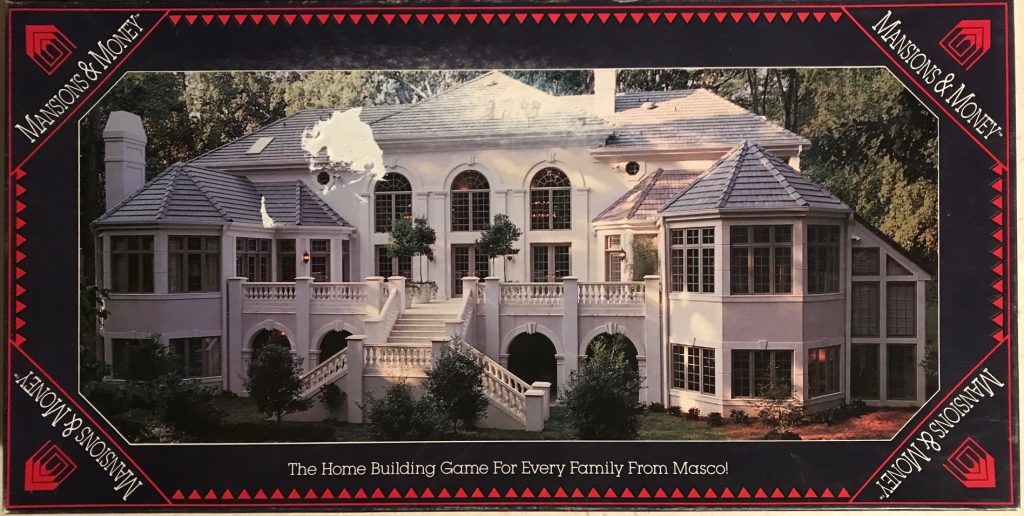
HOW WE MET
It just so happens that John and Keri are building a house right now. I felt sure that they needed to play this Masco game prior to locking down all the details, just in case it changed their minds on anything. I plucked it off eBay as my humble contribution to their home-building journey. I’m a good friend.
HOW IT PLAYS
Mansions & Money is a roll and move game where your goal is to be the wealthiest homeowner when the game ends.
Pawns start on the inner track starting space. On their turn, players roll two dice but only choose one of them for their movement. This definitely allows you to be more strategic about which spaces on the board you land on. If a player rolls doubles then they shout out, “Mansions and Money!” to get $10,000 from the bank. If another player shouts it first, the roller needs to pay the shouter $10,000 from their own supply of money.
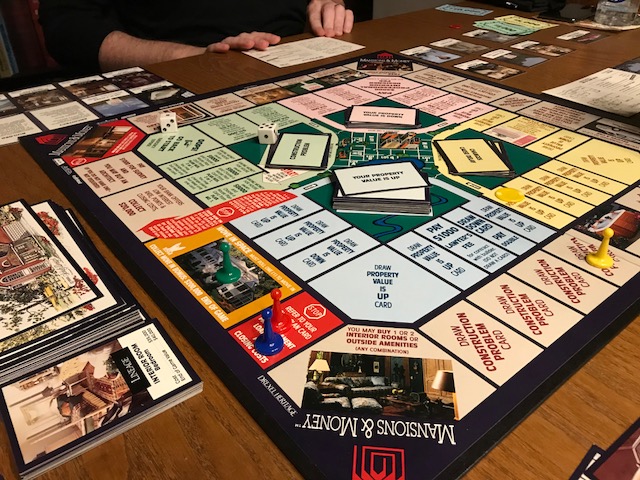
The first several spaces on the board allow players to collect money and choose house plans based on the space they land on. For example a space may allow you to choose a house design from plan numbers 1 or 2. House plans go up to 7 and each tier between 1 and 7 has three different house design choices. If you are able to upgrade by landing on a space that lets you choose from a higher plan, you should go for it. You can simply replace whatever plan you have; players can only have one house plan design.

The board also has spaces indicating YOUR PROPERTY IS UP or YOUR PROPERTY IS DOWN. When landing here, draw a card from the appropriate deck. As you can probably guess YOUR PROPERTY IS UP cards are positive and allow you to collect money and have the option of purchasing a LOT, a BUILDER or an ARCHITECT. You are required to have both a LOT and a BUILDER (or in lieu of BUILDER to get a YOU ARE THE BUILDER card, cheaper but less professional) before you exit the inner track or you will pay a fine to purchase them. The ARCHITECT is optional.
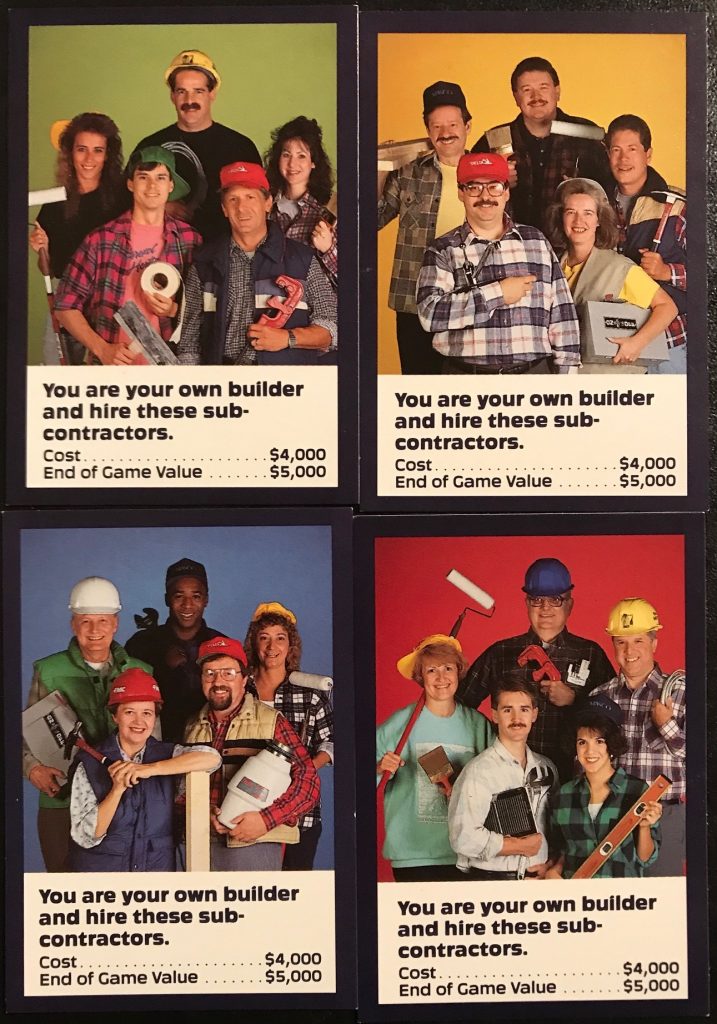
YOUR PROPERTY IS DOWN cards are negative and cause you to pay minor fees for last minute changes or mistakes. By choosing which die you use to move you are unlikely to land on one of these spaces unless you roll doubles and are forced onto it. We never landed on one.
All cards in the game have cheaper options and more expensive options. The cheaper options cost less at the time of purchase but are consequently worth less at the end of the game. The BUILDER and ARCHITECT cards also have more expensive options, and the more expensive ones will protect you from more CONSTRUCTION PROBLEM cards near the end of play.
The inner track is all about collecting money, choosing a house plan, choosing a LOT, choosing a BUILDER and possibly hiring an ARCHITECT. The inner track ends for each player when they reach the red arrow leading pawns into the outer track. Again, if you do not have either a LOT or BUILDER at this point then you still purchase one now but pay an additional $10,000. And money is important to make the best house you can and have the best return at the end of the game.
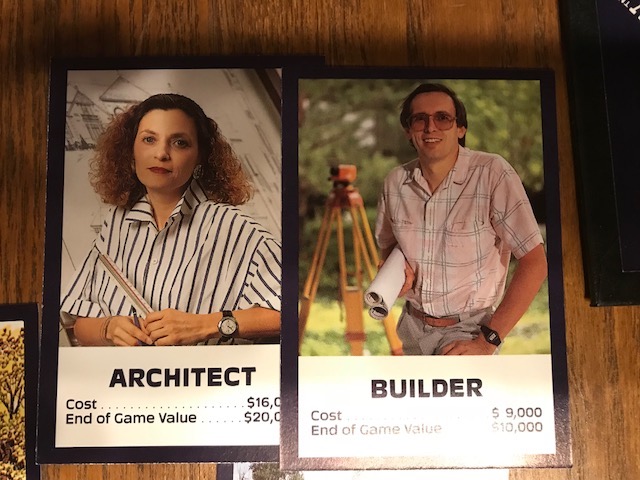
The outer track is full of self-explanatory spaces that might get you a car, might allow you add rooms to your house, collect or pay money, etc. If a space says buy then you must buy, but if it says may buy then you have the option. If you go broke, you temporarily go back into the inner track and collect double money (this is where your colored chip will come into play).
The outer track has three special spaces that are colored red and have STOP signs on them. You are required to STOP at each of these red spaces. What happens on these spaces is indicated on the back of your particular house plan, plus they require a room purchase. For example the first of these spaces requires choosing a KITCHEN to purchase. Money goes quickly on the outer track.
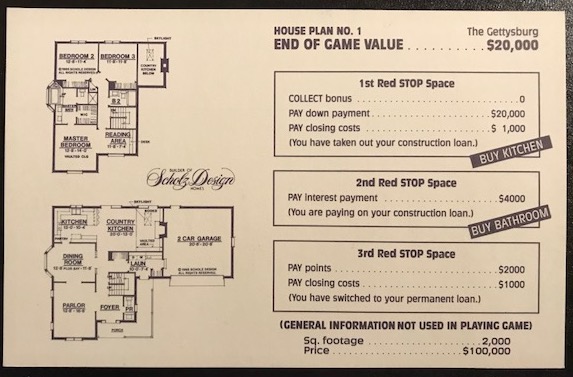
The last several spaces of the game are littered with CONSTRUCTION PROBLEMs that cause you to draw a card from the CONSTRUCTION PROBLEM deck. Your die roll, your BUILDER or your ARCHITECT may protect you from these nasty problems, but if not they do get nasty. Watch out.
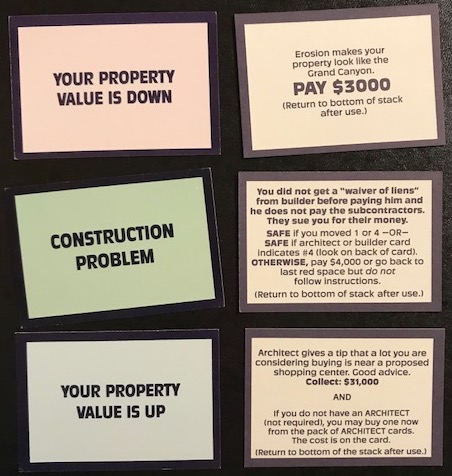
The game ends for all players once any player hits the MOVE IN space. This player also gets a $200,000 bonus! The player with the most money (add up cash, home value, builder, rooms, everything together) wins!
HOW IT WENT
Mansions & Money was everything I had hoped it would be. It is everything you would think a game created by a company using actual branded products and designs over 25 years old would be. Since Masco probably had a genuine interest in selling things from this game, they did not skimp on the choices. We had 21 house designs, 20 outside amenities, 6 kitchens, 6 bathrooms, 5 cars, 5 architects, 5 builders, 8 lots and 28 interior rooms to choose from!
The interior rooms are as delightful as you might imagine for the time period: lots of bright brass faucets, lots of hunter green, lots of lace and flower prints, lots of dark wood.
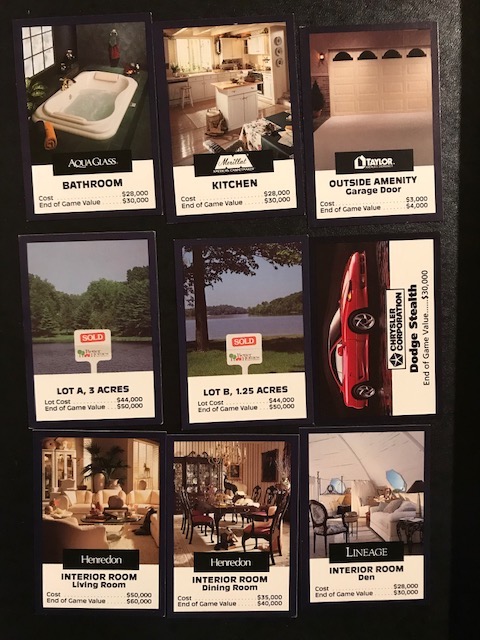
My own house plan was The Villanova, which is a level 4. I just didn’t land on a space to upgrade. We also didn’t know what to expect in terms of how good it is to have a middle-of-the-road design vs a super-fancy one. (Spoiler alert: the rich get richer in Mansions & Money, just like always). Keri was the only one of us that got a level 7 house plan, and it definitely contributed to her ultimate win.

There are other things that can pay off a lot. Taking your time in the inner track will get you more money. You can make a strategic decision to go broke in order to collect a bunch of money, but it will cost you a few turns. Landing on the CEO space and getting a free car is just free money, and a free interior room can really pay off in the end of the game.
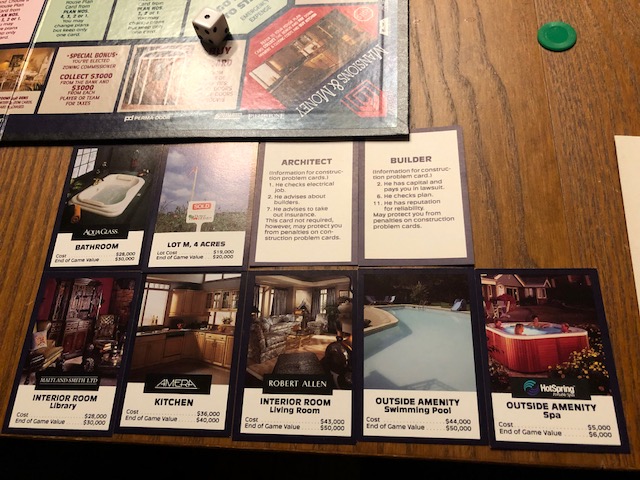
The $200,000 bonus ended up being huge, at least in our play. The three of us losers had between $308,000 and $338,000 and Keri won with $517,000. So she would not have won without that bonus. It’s possible that first to the end will always win – it certainly seems so based on our one play. But how fun is that? I’ll take my time and go for a hot tub.
I frequently could not afford the nicest anything, which was probably very appropriate for my level 4 house plan. Some of us played with the strategy of purchasing the most expensive thing available while others went for a certain look. And we all kind of ended up similarly.
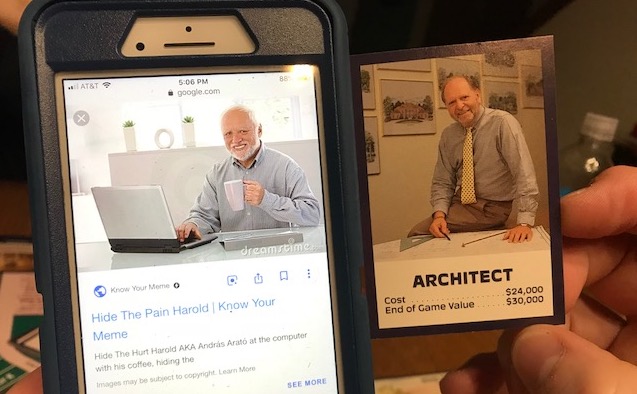
I think our enjoyment of the game was heightened by the fact that half of us were kind of going through the whole process in real life. I imagine that also caused a heightened angst with some of the negative cards, like the one where the framework of a house went up in flames.
The game stayed on theme well with scary-but-probably-realistic CONSTRUCTION PROBLEMs and a kind of you-get-what-you-pay-for feeling. I think a lot of people might not enjoy the dated look of the game, but to me that was a lot of the charm. Although, Masco, if you are listening… if you decide to release a new game I will happily pay money for it.
PLAY OR PASS
Pass. While I grant you that the gameplay here is nothing real special, we all had tons of fun building our 1992 houses with our 1992 workers and their 1992 clothing and hair. Most cash grab games are happy once you have paid for the game; that is their point. This is the first game I remember playing that wants me to buy stuff after playing the game. I’m into it.